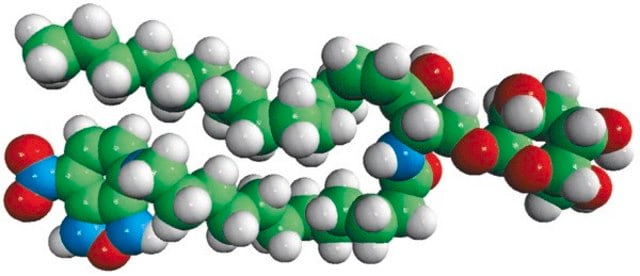860474P
Avanti
1-deoxysphinganine-d3
Avanti Research™ - A Croda Brand 860474P, powder
Synonym(s):
1-deoxysphinganine-d3 (m18:0)
Sign Into View Organizational & Contract Pricing
All Photos(1)
About This Item
Empirical Formula (Hill Notation):
C18H36D3NO
CAS Number:
Molecular Weight:
288.53
UNSPSC Code:
12352211
NACRES:
NA.25
Recommended Products
form
powder
packaging
pkg of 1 × 500 μg (860474P-500ug)
manufacturer/tradename
Avanti Research™ - A Croda Brand 860474P
shipped in
dry ice
storage temp.
−20°C
SMILES string
CCCCCCCCCCCCCCC[C@](O)([H])[C@](N)([H])C([2H])([2H])[2H]
General description
1-deoxysphinganine-d3 is a deuterated compound, wherein the three protons of deoxysphinganine are replaced by deuterium. 1-deoxysphinganine is an atypical sphingoid base devoid of a 1-hydroxyl group.
Biochem/physiol Actions
1-deoxysphinganine acts as a biomarker for Type 2 diabetes. It can function as a cytotoxic lipid for insulin producing cells. 1-deoxysphinganine might exhibit toxicity to cancerous cells.
Packaging
5 mL Amber Glass Screw Cap Vial (860474P-500ug)
Legal Information
Avanti Research is a trademark of Avanti Polar Lipids, LLC
Storage Class Code
11 - Combustible Solids
WGK
WGK 3
Certificates of Analysis (COA)
Search for Certificates of Analysis (COA) by entering the products Lot/Batch Number. Lot and Batch Numbers can be found on a product’s label following the words ‘Lot’ or ‘Batch’.
Already Own This Product?
Find documentation for the products that you have recently purchased in the Document Library.
Deoxysphingolipids, novel biomarkers for type 2 diabetes, are cytotoxic for insulin-producing cells.
Richard A Zuellig et al.
Diabetes, 63(4), 1326-1339 (2014-01-01)
Irreversible failure of pancreatic β-cells is the main culprit in the pathophysiology of diabetes, a disease that is now a global epidemic. Recently, elevated plasma levels of deoxysphingolipids, including 1-deoxysphinganine, have been identified as a novel biomarker for the disease.
Junliang Wan et al.
Journal of agricultural and food chemistry, 67(46), 12953-12961 (2019-10-23)
Most common sphingolipids are comprised of "typical" sphingoid bases (sphinganine, sphingosine, and structurally related compounds) and are produced via the condensation of l-serine with a fatty acyl-CoA by serine palmitoyltransferase. Some organisms, including mammals, also produce "atypical" sphingoid bases that
Our team of scientists has experience in all areas of research including Life Science, Material Science, Chemical Synthesis, Chromatography, Analytical and many others.
Contact Technical Service







